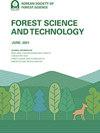Harvest maturity highly affects fruit quality attributes of ethylene-treated ‘autumn sense’ hardy kiwifruit
IF 2.2
Q2 FORESTRY
引用次数: 1
Abstract
Abstract Optimal harvest date is an important quality parameter for hardy kiwifruit. We, therefore, examined the ideal harvest date to obtain high-quality ripe “Autumn sense” hardy kiwifruit. The fruit was harvested at four different harvest maturity stages [6.2%, 7.1%, 8.1%, and 9.1% average soluble solids content (SSC); H1, H2, H3, and H4, respectively], then treated with exogenous ethylene at ambient temperature, to examine the quality of the ripening fruit. The four harvest maturity stages differed significantly in firmness, SSC, titratable acidity (TA), and SSC/TA ratio, both in freshly harvested and ripe hardy kiwifruit (p < 0.001). Fruit firmness at harvest gradually decreased from 32.1 to 25.1 N, while SSC increased steadily as harvest maturity increased. TA increased steadily from 0.8 in H1 to 1.1% in H3, and was lower in H4. After ethylene treatment, the range of firmness was much lower, at 2.7–3.1 N, while SSC increased significantly from 15.1% in H1 to 16.4% in H4. TA decreased significantly from 1.0% at harvest to 0.7% after ethylene treatment, regardless of harvest maturity stage. For H3 fruit, TA was 56% lower after ethylene treatment than before treatment. After treatment, H3 had the highest SSC/TA (p < 0.001). Consumer preference was higher for H3 and H4 than H1 and H2, and was highly correlated with the SSC/TA ratio at harvest and after ethylene treatment, and with SSC at harvest. These results suggest that TA, SSC, and SSC/TA should be considered for determining the optimal harvest maturity for hardy kiwifruit. This study reveals that the quality of ripened hardy kiwifruit can be maximized by controlling harvest maturity.乙烯处理“秋感”耐寒猕猴桃的采收成熟度对果实品质性状影响很大
摘要最佳采收期是耐寒猕猴桃的重要品质参数。因此,我们考察了获得优质成熟“秋感”耐寒猕猴桃的理想采收期。果实在四个不同的采收成熟期采收[6.2%、7.1%、8.1%和9.1%的平均可溶性固形物含量(SSC)];分别为H1, H2, H3和H4],然后在室温下用外源乙烯处理,以检查成熟果实的质量。新鲜猕猴桃和成熟猕猴桃的硬度、SSC、可滴定酸度(TA)和SSC/TA比值在4个收获成熟期均存在显著差异(p < 0.001)。果实结实度从32.1 N逐渐降低到25.1 N,而SSC随着收获成熟度的增加而稳步增加。TA从H1的0.8稳步上升到H3的1.1%,H4更低。乙烯处理后,固结度范围较低,为2.7 ~ 3.1 N,而SSC从H1的15.1%显著增加到H4的16.4%。乙烯处理后的TA含量显著下降,从收获时的1.0%降至0.7%,与收获成熟期无关。乙烯处理后H3果实TA含量较处理前降低56%。治疗后,H3组SSC/TA最高(p < 0.001)。消费者对H3和H4的偏好高于H1和H2,并且与收获时和乙烯处理后的SSC/TA比以及收获时的SSC高度相关。这些结果表明,在确定耐寒猕猴桃最佳采收成熟度时,应考虑TA、SSC和SSC/TA。研究表明,通过控制采收成熟度,可以最大限度地提高成熟耐寒猕猴桃的品质。
本文章由计算机程序翻译,如有差异,请以英文原文为准。
求助全文
约1分钟内获得全文
求助全文

 求助内容:
求助内容: 应助结果提醒方式:
应助结果提醒方式:


